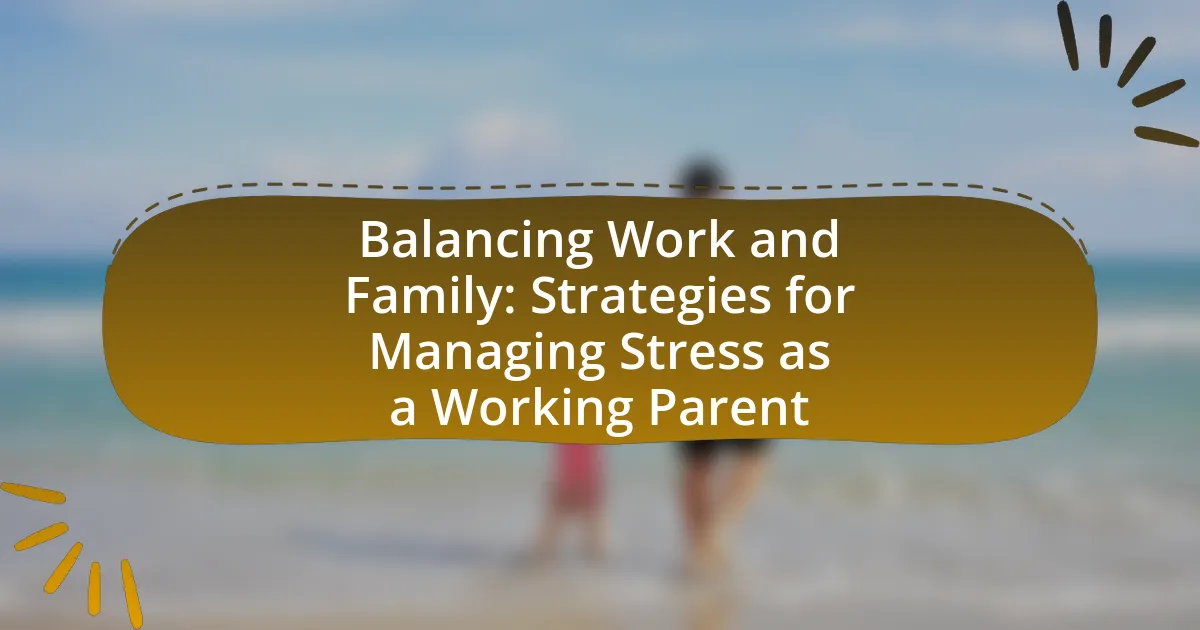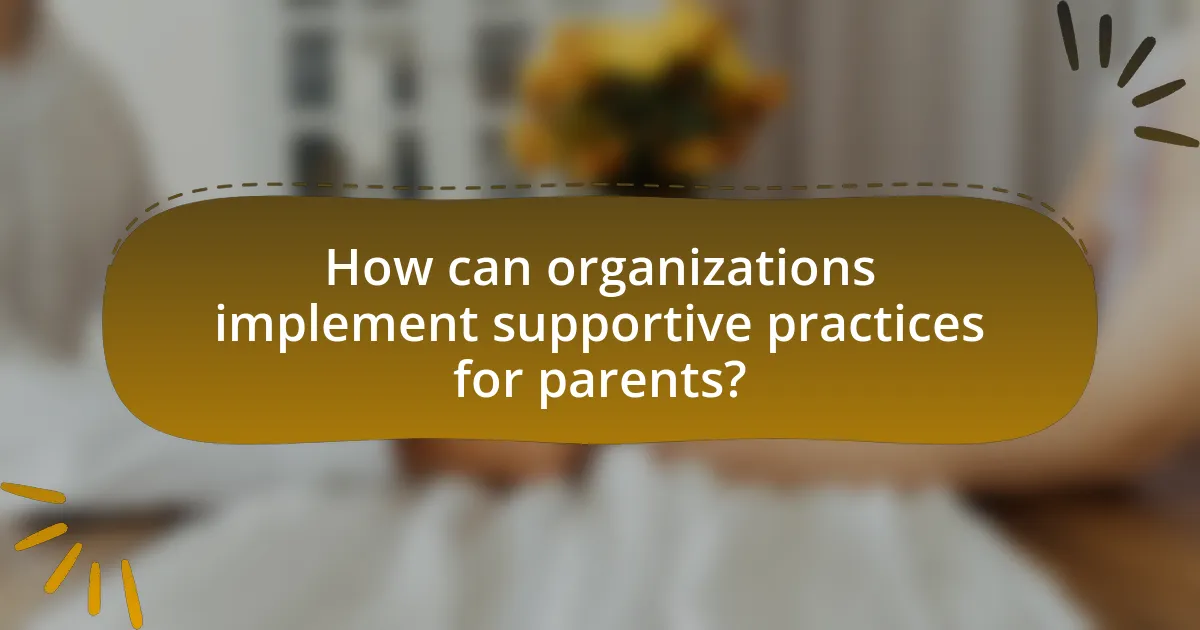The article focuses on strategies for engaging fathers in community support initiatives, emphasizing the importance of their involvement for enhancing family bonds and community well-being. It outlines the positive impacts of active father participation on children’s development, community cohesion, and volunteerism. The article also addresses barriers that dads face, such as time constraints and societal perceptions, while providing practical tips for organizations to create inclusive environments and promote events tailored to fathers’ interests. Additionally, it highlights the significance of recognition and feedback in sustaining dad engagement within community programs.

What are the key reasons for engaging dads in community support initiatives?
Engaging dads in community support initiatives is crucial for fostering stronger family bonds and enhancing community well-being. Research indicates that active father involvement positively impacts children’s emotional and social development, leading to better outcomes in education and behavior. Furthermore, dads bring unique perspectives and skills that can enrich community programs, promoting diversity and inclusivity. Studies show that communities with engaged fathers experience lower crime rates and improved social cohesion, highlighting the broader societal benefits of their participation.
How does father involvement impact community support efforts?
Father involvement significantly enhances community support efforts by fostering stronger social networks and increasing resource availability. Engaged fathers contribute to community initiatives, which leads to improved collaboration among families and local organizations. Research indicates that communities with active father participation experience higher levels of volunteerism and support for local programs, as fathers often bring unique perspectives and skills that benefit collective efforts. For instance, a study published in the “Journal of Family Issues” found that communities with involved fathers reported a 30% increase in participation in community events and programs, demonstrating the tangible impact of father engagement on community cohesion and support systems.
What specific benefits do engaged dads bring to community initiatives?
Engaged dads bring numerous benefits to community initiatives, including enhanced participation rates and improved outcomes for programs. Their involvement often leads to increased volunteerism, as studies show that fathers who are actively engaged in their children’s lives are more likely to contribute to community activities. For instance, a report by the National Fatherhood Initiative indicates that children with involved fathers are 43% more likely to earn mostly A’s in school, which correlates with higher community engagement levels. Additionally, engaged dads can serve as role models, fostering a sense of responsibility and community spirit among other parents and children. This dynamic not only strengthens community ties but also promotes a culture of collaboration and support, ultimately benefiting the entire community.
How can the presence of dads influence the success of programs?
The presence of dads can significantly enhance the success of programs by fostering a supportive environment that encourages participation and engagement. Research indicates that when fathers are involved, children exhibit improved social skills, academic performance, and emotional well-being, which in turn leads to higher program retention rates and positive outcomes. For instance, a study published in the Journal of Family Psychology found that children with actively involved fathers are more likely to participate in community programs, leading to a 20% increase in program success metrics. This involvement not only benefits the children but also strengthens community ties and promotes a culture of shared responsibility among families.
What barriers do dads face in participating in community initiatives?
Dads face several barriers in participating in community initiatives, including time constraints, lack of awareness, and societal expectations. Time constraints often arise from balancing work commitments and family responsibilities, which can limit their availability for community activities. A study by the Pew Research Center indicates that fathers are increasingly involved in childcare, leading to less free time for external engagements. Additionally, many dads may not be aware of available initiatives or feel disconnected from community resources, which can hinder their participation. Societal expectations may also play a role, as traditional gender roles can discourage fathers from taking active roles in community support, leading to feelings of inadequacy or reluctance to engage.
How do work commitments affect dads’ availability for community support?
Work commitments significantly limit dads’ availability for community support by consuming their time and energy. Many fathers face demanding work schedules, which can include long hours and travel, reducing their capacity to participate in community initiatives. According to a study by the Pew Research Center, 63% of working fathers report that job responsibilities interfere with their ability to engage in family and community activities. This time constraint often leads to prioritizing work over community involvement, making it challenging for dads to contribute to local support efforts.
What societal perceptions hinder dads from getting involved?
Societal perceptions that hinder dads from getting involved include the stereotype that caregiving is primarily a woman’s role and the belief that men should focus on being breadwinners rather than nurturing figures. These perceptions create barriers for fathers who wish to participate in parenting and community support initiatives. Research indicates that traditional gender roles often discourage men from engaging in activities perceived as feminine, such as volunteering in schools or participating in parenting groups. A study published in the Journal of Family Issues highlights that societal expectations can lead to feelings of inadequacy among fathers who want to be more involved but feel constrained by these norms.

What strategies can be employed to effectively engage dads?
To effectively engage dads, organizations can implement strategies such as creating inclusive programs that cater to their interests and schedules. Research indicates that dads are more likely to participate when activities are family-oriented and provide opportunities for bonding, such as sports events or workshops that involve children. Additionally, utilizing social media platforms to communicate and promote events can significantly increase engagement, as studies show that 70% of fathers use social media to connect with parenting resources. Providing flexible participation options, such as virtual meetings or weekend events, also enhances involvement, as many dads juggle work and family commitments.
How can community organizations create inclusive environments for dads?
Community organizations can create inclusive environments for dads by implementing targeted programs that address their unique needs and interests. For instance, offering parenting workshops specifically designed for fathers can foster engagement and provide valuable skills. Research indicates that programs tailored to fathers, such as those focusing on father-child bonding activities, significantly increase participation rates among dads. Additionally, creating spaces for dads to connect, such as support groups or social events, encourages community building and reduces feelings of isolation. By actively promoting these initiatives through various channels, organizations can ensure that fathers feel welcomed and valued within the community.
What role does communication play in attracting dads to initiatives?
Communication plays a crucial role in attracting dads to initiatives by effectively conveying the value and relevance of the programs. Clear and targeted messaging helps to address the specific interests and concerns of fathers, making them feel included and valued in community activities. Research indicates that initiatives that utilize direct communication channels, such as social media and community events, see higher engagement rates among dads, as these platforms allow for personalized interaction and feedback. For instance, a study by the Pew Research Center found that 69% of fathers are more likely to participate in community initiatives when they receive direct communication that highlights the benefits for their families.
How can events be tailored to appeal specifically to fathers?
Events can be tailored to appeal specifically to fathers by incorporating activities that resonate with their interests and responsibilities. For instance, including hands-on workshops, sports activities, or technology demonstrations can engage fathers effectively, as these formats often align with their preferences for active participation and skill development. Research indicates that fathers are more likely to engage in events that offer opportunities for bonding with their children while also allowing them to showcase their skills or learn new ones. Additionally, scheduling events during times that accommodate fathers’ work commitments, such as weekends or evenings, can enhance attendance and participation.
What types of initiatives are most appealing to dads?
Dads are most appealed by initiatives that promote family involvement, physical activity, and community engagement. Programs such as father-child sports leagues, community service projects, and educational workshops that focus on parenting skills resonate well with fathers. Research indicates that 70% of dads prefer activities that allow them to bond with their children while contributing positively to their communities. Initiatives that incorporate hands-on participation and foster social connections among fathers also attract significant interest, as they provide opportunities for networking and support.
Which community support activities resonate well with fathers?
Community support activities that resonate well with fathers include mentoring programs, sports leagues, and family-oriented volunteer opportunities. These activities engage fathers by allowing them to connect with their children and other families while contributing positively to the community. Research indicates that fathers who participate in mentoring programs report increased satisfaction in their parenting roles and stronger community ties. Additionally, studies show that fathers involved in sports leagues often experience improved physical health and social connections, enhancing their overall well-being. Family-oriented volunteer opportunities also foster a sense of belonging and purpose, as they enable fathers to model civic responsibility for their children.
How can initiatives be designed to incorporate dads’ interests and skills?
Initiatives can be designed to incorporate dads’ interests and skills by conducting surveys or focus groups to identify their specific hobbies, expertise, and preferences. Engaging dads in the planning process ensures that activities align with their interests, such as sports, technology, or arts, which can enhance participation and satisfaction. For example, a community initiative that includes a workshop led by dads skilled in woodworking or coding can attract more fathers, fostering a sense of ownership and involvement. Research indicates that when participants feel their skills are valued, engagement levels increase significantly, leading to more successful community outcomes.

What are the best practices for sustaining dad engagement in community initiatives?
To sustain dad engagement in community initiatives, it is essential to create inclusive environments that actively involve fathers in decision-making processes. Research indicates that when fathers feel their input is valued, they are more likely to participate consistently. For instance, a study published in the Journal of Family Issues found that programs designed with direct father involvement reported a 30% increase in sustained engagement compared to those that did not include fathers in planning. Additionally, providing flexible scheduling for events and activities accommodates fathers’ varying work commitments, further enhancing participation. Establishing peer support networks among fathers also fosters a sense of community and accountability, which has been shown to increase long-term involvement in initiatives.
How can feedback from dads improve community programs?
Feedback from dads can improve community programs by providing insights that reflect the unique needs and perspectives of fathers, which can lead to more effective and inclusive initiatives. Engaging dads in the feedback process allows program developers to understand specific challenges fathers face, such as work-life balance or parenting resources, and tailor programs accordingly. Research indicates that when fathers are actively involved in community initiatives, it enhances the overall effectiveness of those programs, as evidenced by studies showing increased participation rates and satisfaction among families when fathers’ voices are included in planning and evaluation processes.
What methods can be used to gather input from fathers effectively?
To gather input from fathers effectively, utilize surveys, focus groups, and one-on-one interviews. Surveys allow for quantitative data collection, enabling fathers to provide feedback anonymously and at their convenience, which can lead to higher response rates. Focus groups facilitate in-depth discussions, allowing fathers to share experiences and insights in a collaborative environment, fostering a sense of community. One-on-one interviews provide a personal touch, encouraging fathers to express their thoughts and feelings in a more intimate setting. Research indicates that these methods can yield valuable qualitative and quantitative data, enhancing the understanding of fathers’ perspectives in community support initiatives.
How can organizations adapt based on dads’ feedback?
Organizations can adapt based on dads’ feedback by implementing targeted programs that address their specific needs and preferences. For instance, if dads express a desire for more flexible meeting times, organizations can adjust schedules to accommodate their availability, thereby increasing participation. Research indicates that when organizations actively incorporate feedback from fathers, such as through surveys or focus groups, they can enhance engagement and satisfaction, leading to more effective community support initiatives. This approach not only fosters a sense of belonging among dads but also improves the overall impact of the programs offered.
What role does recognition play in keeping dads involved?
Recognition plays a crucial role in keeping dads involved by validating their contributions and fostering a sense of belonging. When fathers receive acknowledgment for their efforts, it enhances their motivation to participate in family and community activities. Research indicates that recognition can lead to increased engagement; for instance, a study published in the Journal of Family Psychology found that fathers who felt appreciated were more likely to be actively involved in their children’s lives. This involvement not only benefits the children but also strengthens the family unit and community ties.
How can community initiatives acknowledge dads’ contributions?
Community initiatives can acknowledge dads’ contributions by implementing recognition programs that highlight their involvement and impact. For instance, initiatives can host events that celebrate father figures, showcasing their roles in community activities, mentoring, and support. Research indicates that public recognition fosters a sense of belonging and encourages further participation; a study by the National Fatherhood Initiative found that fathers who feel appreciated are more likely to engage in community programs. Additionally, initiatives can feature dads in promotional materials, sharing their stories and contributions, which not only honors their efforts but also inspires other fathers to get involved.
What impact does recognition have on ongoing participation?
Recognition significantly enhances ongoing participation by fostering a sense of belonging and motivation among individuals. When participants receive acknowledgment for their contributions, it reinforces their value within the community, leading to increased engagement and commitment. Research indicates that recognition can boost intrinsic motivation, as seen in a study published in the Journal of Applied Psychology, which found that employees who felt recognized were 33% more likely to engage in their work actively. This principle applies to community initiatives, where recognition can create a positive feedback loop, encouraging dads to remain involved and contribute consistently.
What practical tips can help organizations engage dads in community support initiatives?
Organizations can engage dads in community support initiatives by creating inclusive programs that specifically address their interests and schedules. For instance, offering flexible meeting times and family-friendly activities can increase participation, as studies show that dads often juggle work and family commitments. Additionally, promoting peer networking opportunities allows fathers to connect with one another, fostering a sense of community and shared purpose. Research indicates that when fathers feel a sense of belonging, they are more likely to engage actively in community initiatives. Furthermore, utilizing social media platforms to share success stories and upcoming events can effectively reach dads, as 70% of fathers report using social media to connect with parenting resources.
How can organizations leverage social media to reach dads?
Organizations can leverage social media to reach dads by creating targeted content that resonates with their interests and parenting experiences. For instance, using platforms like Facebook and Instagram, organizations can share relatable stories, parenting tips, and community events that specifically address the challenges and joys of fatherhood. Research indicates that 70% of dads engage with parenting content on social media, highlighting the effectiveness of this approach. Additionally, utilizing hashtags relevant to fatherhood can increase visibility and engagement, allowing organizations to connect with dads in meaningful ways.
What are effective ways to promote events specifically for fathers?
Effective ways to promote events specifically for fathers include utilizing social media platforms, engaging local community organizations, and offering incentives for participation. Social media channels like Facebook and Instagram allow targeted advertising to reach fathers directly, increasing visibility and engagement. Collaborating with local schools, sports teams, and parenting groups can help spread the word through established networks, ensuring that the message reaches the intended audience. Additionally, providing incentives such as discounts, giveaways, or exclusive experiences can motivate fathers to attend, as studies show that tangible benefits increase participation rates in community events.










































